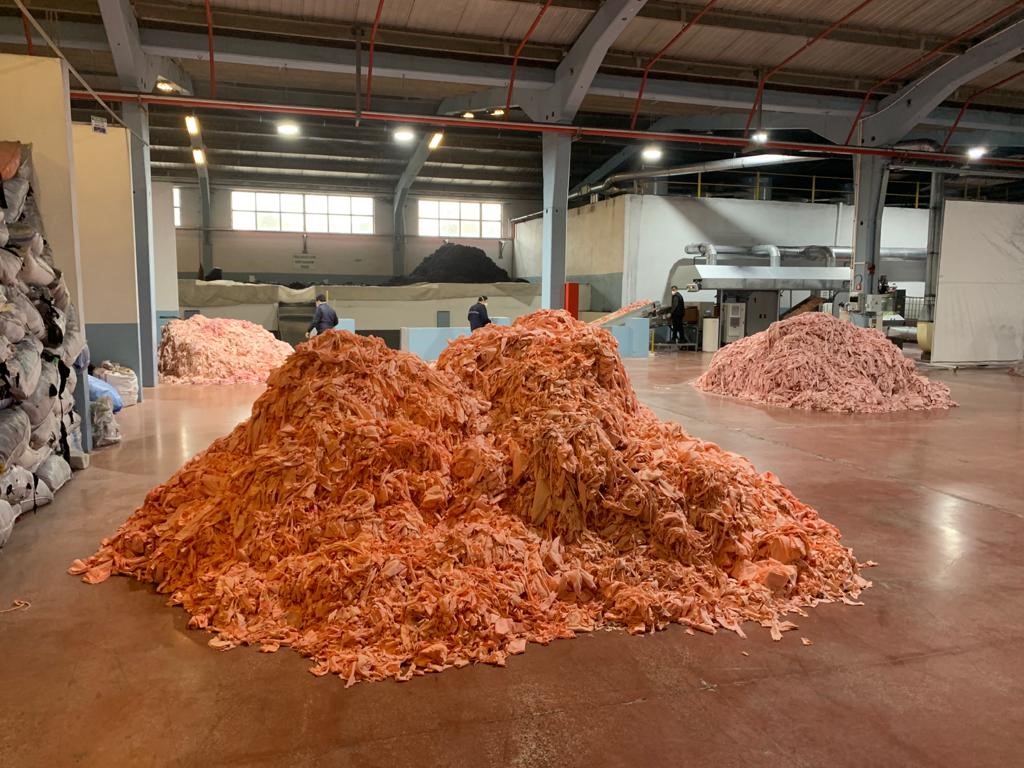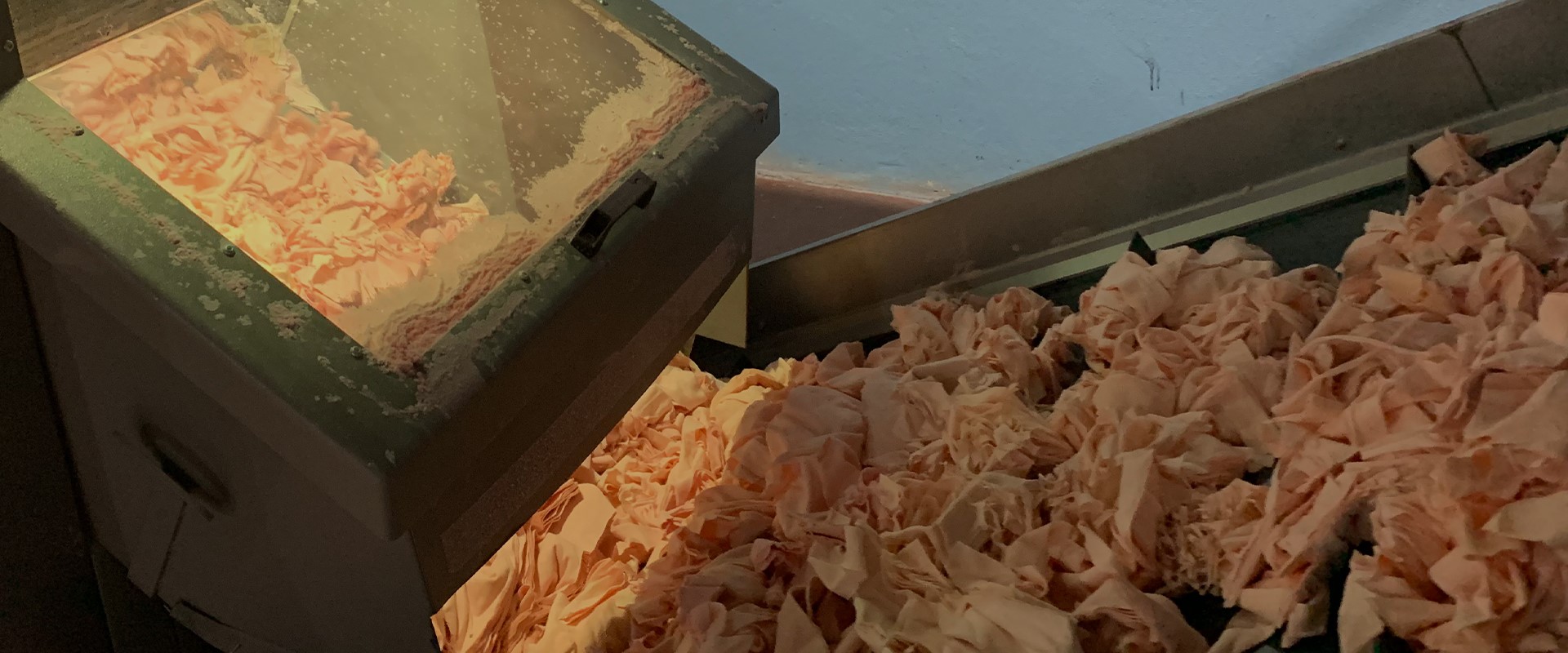
Low impact materials
Garment Circularity
Waste has become a resource. Whether we are talking about packaging or garments, through our targets we intend to reduce, recycle or repurpose our waste.
Superdry has always designed and crafted garments to the highest quality, with longevity of material and style in mind to ensure we meet the needs of our consumers. Our garments are made not just to be worn but worn out.

To start closing the loop, we’re going beyond extending the life of our garments, by implementing other initiatives to lower our impact.
We are committed to recycling or reusing over 2,000 tonnes of fabric waste per year by 2025 - this equates to approximately 17% of our total fabric footprint or 100% of our estimated waste fabric produced during the cutting process every year. This year, we achieved 570 tonnes of fabric, 29% of our target.
Buying what we need
Since 2019 we have reduced our intake considerably and have rebalanced our collection towards core ranges that do not have as high fashion risk and can be carried over into subsequent seasons if necessary. This has resulted in a 42% reduction in our buy volume in the last three years.
A critical part of the process in making durable, sustainable garments is our sampling system; ensuring the garments meet our quality and technical needs, as well providing real visuals for our brand marketing and sales team to use to help our customers have the best experience with our products.
To reduce our overall sampling footprint, we are establishing
- Digital showrooms
- Swatch cards to reduce sampling, across multiple colours of the same garment. Our target is to reduce sampling requirement by 20% (40,000 units annually).
- Increasing resale. We currently resell to colleagues through our staff shop and looking to increase the proportion of these garments being sold through multiple routes.
Once the samples have served their initial purpose, we ensure the most sustainable route is taken such as restocking the item in our warehouse, selling through outlet stores and staff shops, and donating to our charity partner.
No faulty products are sent to landfill
No faulty products are sent to landfill by Superdry. Even though our faulty returns continue at a market-leading low rate, we have been working with our UK owned stores and distribution centres to train colleagues to identify fixable returns (eg small marks) and have provided them with ‘care kits’ to service these garments so they can be sold again.
In FY23 this scheme has re-processed 25,149 garments from faulty stock, generating over £290,000 in revenue through full price and staff-shop sales.
We continue donate the balance of our faulty returns to Newlife (76 tonnes in the last year), a UK based charity who reprocess and resell them to fund equipment for disabled and terminally ill children. The donations raised over £350,000.
Fabric Recycling
In FY23, our key jersey factories sent over 420 tonnes of cut (fabric scrap) waste, and second quality garments to local recycling partners in Turkey and India.
By mechanically recycling this fabric waste, and blending it with recycled polyester, we created our first fully recycled fabric, launching it in Autumn Winter 21, in our first fully
recycled hoodie and t-shirt collection.
In FY23 we produced 105,320 garments from the recycled cut waste.


The factories initially segregate the waste by colour and composition. Else then pick it up and transport it to their state-of-the-art facility just outside of Istanbul where they shred it and blend it into 100% recycled fibres.
As recycled fibres are mechanically shredded, they are typically shorter in length, Else therefore combine the recycled fibres with a small amount (about 30%) polyester to help strengthen them.
Else then spin theses fibres into coloured yarns in their state of the art spinning facility.
Our new fully recycled range, launched in September 2021 has been produced using these yarns, saving 95% in each garment's water footprint, and 25% in carbon.
End of Life
In February 2022 we launched our partnership with Oxfam across our UK and Republic of Ireland (ROI) full-price owned retail estate. Within the first three months, customers donated one tonne of pre-loved garments via this route.
In the UK, 13 million clothing items goes to landfill every week, but by partnering with Oxfam, our customers are helping divert 47 million items away from there and into someone's wardrobe.
Our stores are twinned with their local Oxfam shop, which will minimise the distance the clothes travel to reach their new home, as well as supporting the communities they operate in.
The partnership helps customers give their preloved clothes a new lease of life whilst positively impacting someone else's.
This partnership will not only help us to reduce our waste, but also provides an effective way to engage with a new generation of conscious consumers and encourage them to shop more sustainably.
"We're excited to be partnered with Superdry to help people donate clothes to Oxfam, which will raise vital funds to fight poverty around the world."
- Danny Sriskandarajah, Chief Executive of Oxfam GB
Durable, we keep our garments in use for longer
On average consumers wear clothes 36% less often than they did 15 years ago. By building our garments to last, we aim to reduce their overall carbon and water footprint. Making your garment last will drastically reduce its overall environmental footprint, with organisations including the Carbon Trust estimating a 24% reduction in emissions by extending the lifespan of a garment by one year.
To do this, we employ rigorous quality testing by independent labs – going above industry base test standards. By implements these rigorous additional tests, we can significantly reduce common faults.
Buttons: Our buttons are attached using specialist “button whipping” machines to keep them in place for the lifetime of the garment.
Care labels: care labels provide garment care instructions that allows the user to extend the life and reduce the environmental impact of their Superdry product (e.g. washing at cooler temperatures to reduce energy and reduce fabric wear).
We also share information with our customers on how they can care for their garments to help them live their best life - directly from our quality and technical team. Read their top tips HERE.
We use recycled & low impact materials at scale across our range
In addition to moving to 100% Organic Cotton or cotton in conversion by 2030, we will continue to drive the use of sustainable alternative materials at scale across our range, our target is that 80% of our non-cotton ranges will be converted to lower Impact by 2030.
You can read about our use of Organic Cotton, Recycled Polyester, Tencel and Linen. HERE.
